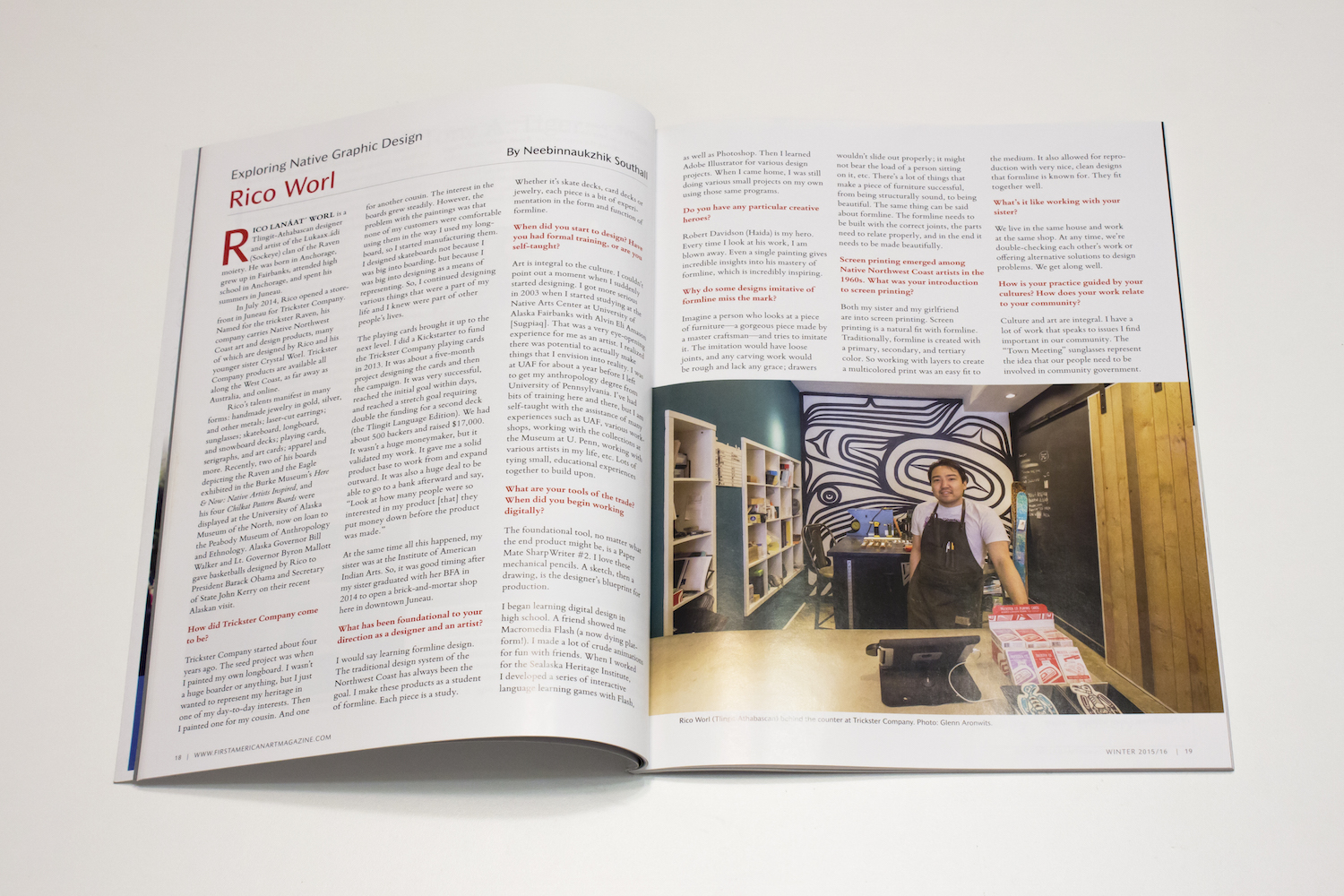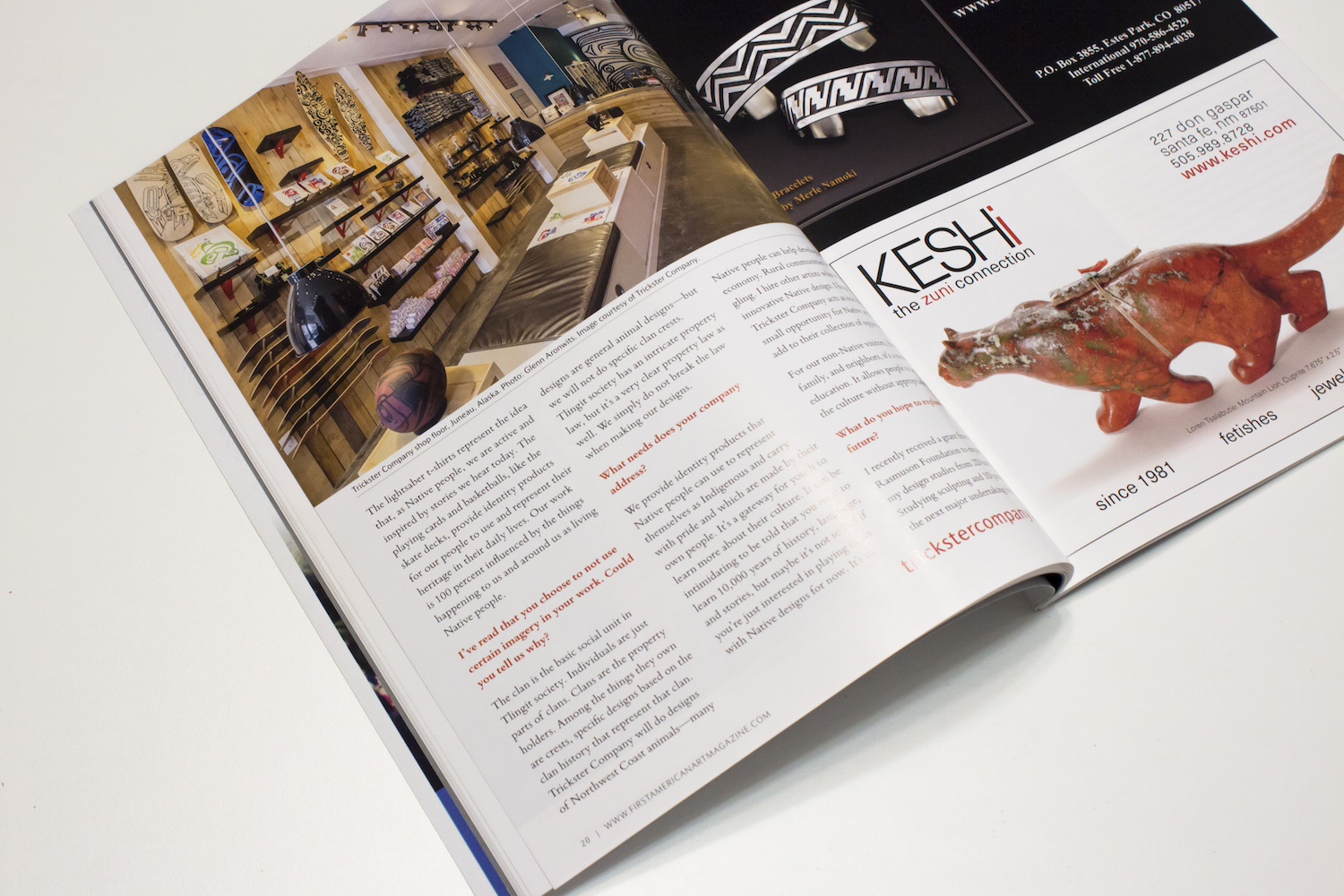My article, Exploring Native Design: Rico Worl, featuring an interview iwth Tlingit/Athabaskan designer Rico Worl of Trickster Company in the Winter 2015/2016 issue of First American Art Magazine.
Rico Worl
by Neebinnaukzhik Southall
As appears in First American Art Magazine
RICO LANÁAT ́ WORL is a Tlingit-Athabascan designer and artist of the Lukaax.ádi (Sockeye) clan of the Raven moiety. He was born in Anchorage, grew up in Fairbanks, attended high school in Anchorage, and spent his summers in Juneau.
In July 2014, Rico opened a store- front in Juneau for Trickster Company. Named for the trickster Raven, his company carries Native Northwest Coast art and design products, many
of which are designed by Rico and his younger sister Crystal Worl. Trickster Company products are available all along the West Coast, as far away as Australia, and online.
Rico’s talents manifest in many forms: handmade jewelry in gold, silver, and other metals; laser-cut earrings; sunglasses; skateboard, longboard, and snowboard decks; playing cards, serigraphs, and art cards; apparel and more. Recently, two of his boards depicting the Raven and the Eagle exhibited in the Burke Museum’s Here & Now: Native Artists Inspired, and his four Chilkat Pattern Boards were displayed at the University of Alaska Museum of the North, now on loan to the Peabody Museum of Anthropology and Ethnology. Alaska Governor Bill Walker and Lt. Governor Byron Mallott gave basketballs designed by Rico to President Barack Obama and Secretary of State John Kerry on their recent Alaskan visit.
How did Trickster Company come to be?
Trickster Company started about four years ago. The seed project was when I painted my own longboard. I wasn’t a huge boarder or anything, but I just wanted to represent my heritage in one of my day-to-day interests. Then I painted one for my cousin. And one for another cousin. The interest in the boards grew steadily. However, the problem with the paintings was that none of my customers were comfortable using them in the way I used my longboard, so I started manufacturing them. I designed skateboards not because I was big into boarding, but because I was big into designing as a means of representing. So, I continued designing various things that were a part of my life and I knew were part of other people’s lives.
The playing cards brought it up to the next level. I did a Kickstarter to fund the Trickster Company playing cards in 2013. It was about a five-month project designing the cards and then the campaign. It was very successful, reached the initial goal within days, and reached a stretch goal requiring double the funding for a second deck (the Tlingit Language Edition). We had about 500 backers and raised $17,000. It wasn’t a huge moneymaker, but it validated my work. It gave me a solid product base to work from and expand outward. It was also a huge deal to be able to go to a bank afterward and say, “Look at how many people were so interested in my product [that] they put money down before the product was made.”
At the same time all this happened, my sister was at the Institute of American Indian Arts. So, it was good timing after my sister graduated with her BFA in 2014 to open a brick-and-mortar shop here in downtown Juneau.
What has been foundational to your direction as a designer and an artist?
I would say learning formline design. The traditional design system of the Northwest Coast has always been the goal. I make these products as a student of formline. Each piece is a study. Whether it’s skate decks, card decks or jewelry, each piece is a bit of experimentation in the form and function of formline.
When did you start to design? Have you had formal training, or are you self-taught?
Art is integral to the culture. I couldn’t point out a moment when I suddenly started designing. I got more serious in 2003 when I started studying at the Native Arts Center at University of Alaska Fairbanks with Alvin Eli Amason [Sugpiaq]. That was a very eye-opening experience for me as an artist. I realized there was potential to actually make things that I envision into reality. I was at UAF for about a year before I left to get my anthropology degree from University of Pennsylvania. I’ve had bits of training here and there, but I am self-taught with the assistance of many experiences such as UAF, various work- shops, working with the collections at the Museum at U. Penn, working with various artists in my life, etc. Lots of tying small, educational experiences together to build upon.
What are your tools of the trade? When did you begin working digitally?
The foundational tool, no matter what the end product might be, is a Paper Mate SharpWriter #2. I love these mechanical pencils. A sketch, then a drawing, is the designer’s blueprint for production.
I began learning digital design in high school. A friend showed me Macromedia Flash (a now dying platform!). I made a lot of crude animations for fun with friends. When I worked for the Sealaska Heritage Institute,
I developed a series of interactive language learning games with Flash, as well as Photoshop. Then I learned Adobe Illustrator for various design projects. When I came home, I was still doing various small projects on my own using those same programs.
Do you have any particular creative heroes?
Robert Davidson (Haida) is my hero. Every time I look at his work, I am blown away. Even a single painting gives incredible insights into his mastery of formline, which is incredibly inspiring.
Why do some designs imitative of formline miss the mark?
Imagine a person who looks at a piece of furniture—a gorgeous piece made by a master craftsman—and tries to imitate it. The imitation would have loose joints, and any carving work would be rough and lack any grace; drawers wouldn’t slide out properly; it might not bear the load of a person sitting on it, etc. There’s a lot of things that make a piece of furniture successful, from being structurally sound, to being beautiful. The same thing can be said about formline. The formline needs to be built with the correct joints, the parts need to relate properly, and in the end it needs to be made beautifully.
Screen printing emerged among Native Northwest Coast artists in the 1960s. What was your introduction to screen printing?
Both my sister and my girlfriend are into screen printing. Screen printing is a natural fit with formline. Traditionally, formline is created with a primary, secondary, and tertiary color. So working with layers to create a multicolored print was an easy fit to the medium. It also allowed for reproduction with very nice, clean designs that formline is known for. They fit together well.
What’s it like working with your sister?
We live in the same house and work at the same shop. At any time, we’re double-checking each other’s work or offering alternative solutions to design problems. We get along well.
How is your practice guided by your cultures? How does your work relate to your community?
Culture and art are integral. I have a lot of work that speaks to issues I find important in our community. The “Town Meeting” sunglasses represent the idea that our people need to be involved in community government. The lightsaber t-shirts represent the idea that, as Native people, we are active and inspired by stories we hear today. The playing cards and basketballs, like the skate decks, provide identity products for our people to use and represent their heritage in their daily lives. Our work is 100 percent influenced by the things happening to us and around us as living Native people.
I’ve read that you choose to not use certain imagery in your work. Could you tell us why?
The clan is the basic social unit in Tlingit society. Individuals are just parts of clans. Clans are the property holders. Among the things they own are crests, specific designs based on the clan history that represent that clan. Trickster Company will do designs of Northwest Coast animals—many designs are general animal designs—but we will not do specific clan crests. Tlingit society has an intricate property law, but it’s a very clear property law as well. We simply do not break the law when making our designs.
What needs does your company address?
We provide identity products that Native people can use to represent themselves as Indigenous and carry with pride and which are made by their own people. It’s a gateway for youth to learn more about their culture. It can be intimidating to be told that you need to learn 10,000 years of history, language, and stories, but maybe it’s not so bad if you’re just interested in playing cards with Native designs for now. It’s so Native people can help develop a Native economy. Rural communities are struggling. I hire other artists who represent innovative Native design. I hope that Trickster Company acts as one more small opportunity for Native artists to add to their collection of opportunities.
For our non-Native visitors, friends, family, and neighbors, it’s a means of education. It allows people to appreciate the culture without appropriating.
What do you hope to explore in the future?
I recently received a grant from the Rasmuson Foundation to expand my design studies from 2D into 3D. Studying sculpting and 3D printing is the next major undertaking for me.

